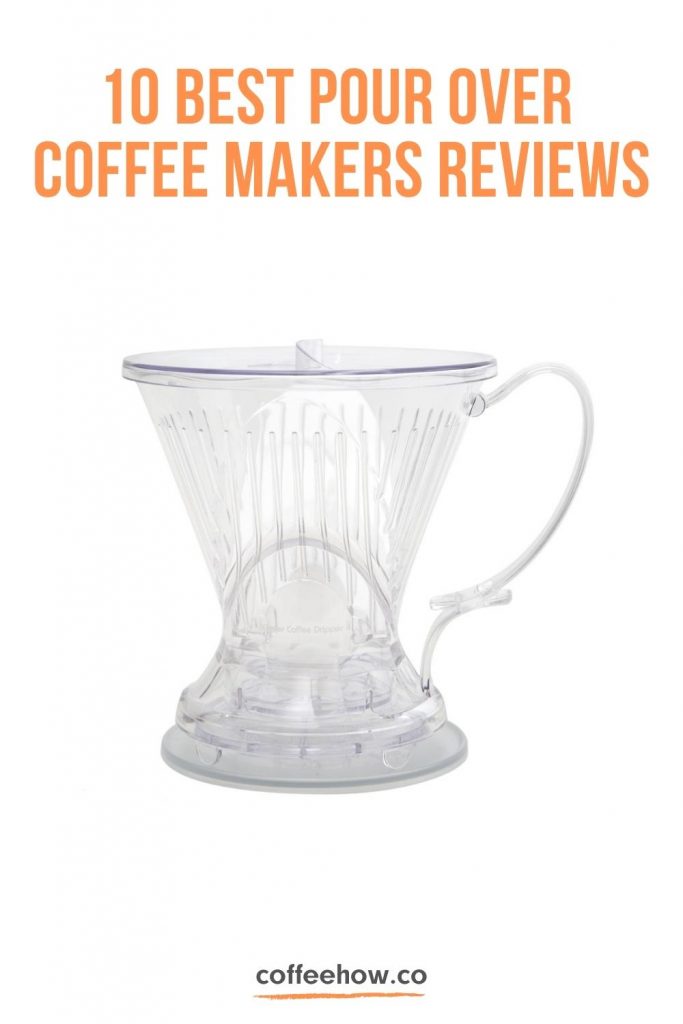fbq('trackCustom', 'view_shop_gear'); var trackEvent = 'shop_gear'; If you love coffee, you probably already know the…
Tired of dumping out full pots of coffee?
Are you looking for a way to get excellent, clean-tasting brew at home?
If you answered yes to either question, then it’s time to explore the world of manual coffee brewing. Using a pour over coffee maker is a great way to make high-quality one cup of coffee at a time.
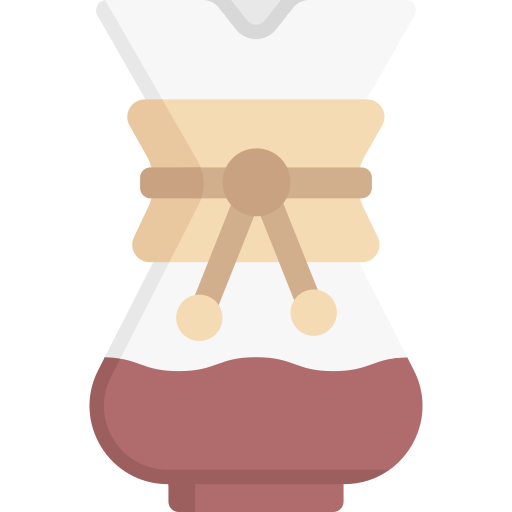
When we say pour over coffee or pour over coffee maker, we are referring to a manual drip coffee maker. Basically, you put coffee grounds in some type of filter and pour hot water over it. The water percolates down through the grinds and out the bottom of the device.
Cafes often use this simple method to brew coffee. It is preferred by many experienced baristas to use pour over coffee maker when they make coffee at home. But don’t let that put you off. Pour Over coffee brewers may have a bad rap for being difficult, but that is not necessarily so.
You certainly can spend hours perfecting the perfect pour over. But with some brewers, if you can boil water, you can make a great pour-over coffee.
Now the question: do you need one? If you truly want to experience the full depth of what speciality coffee tastes like, then yes, you do.

Here we rounded up what we think are the best pour over coffee makers. Many of them are well suited for the beginner while others let your mastery shine through.
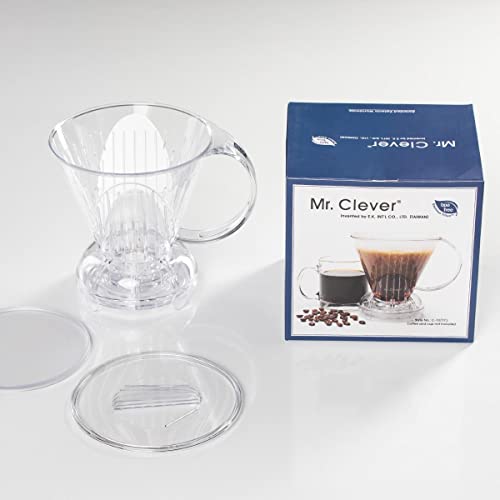
This dripper has a truly clever design. It's also a great choice for those new to the pour-over brewing experience. It has a stopper valve to hold the hot water and coffee grounds, allowing it to steep. When you're ready, you release the pure coffee into your cup.
The result is coffee with the flavor and body of a French press but without any grinds sneaking in. Also, you don't have to babysit the brewing process as you do with the slow pour-over style. With many pour-over brewing systems, you need to precisely control the water flow. The Clever style lets you pour it all in, wait a couple of minutes, then release it. Of course, if you want to get the clarity from a slow pour, just leave the valve open.
The Clever company makes a paper filter specially designed for this dripper to make pour over coffee. While it may seem the same as your regular #4 cone filter, it has some differences. Primarily, it allows a faster flow. That way you don't get over-extracted coffee when you use the stopper valve.

This is the dripper for the control freak! The Hario V60 Ceramic Coffee Dripper has a single (also available in glass, plastic, or metal), large hole in the bottom. To make pour over coffee, the key to proper brewing is a slow, steady pour. If you just dump all the water in at once, it will drain right through and you'll have under-extracted coffee.
The ridges on the inside of the Hario V60 Coffee Dripper are there for a purpose. They help keep the paper filter from sticking to the sides of the dripper. That ensures that the water percolates through the grounds, giving a better extraction.
This Hario V60 Ceramic Coffee Dripper is available in a variety of colors: white, red, black, turquoise, purple, olive green, pink, and navy. You can also get this dripper in two sizes. The smaller one is perfect for travel and lets you set it directly on your coffee mug. The larger is best brewed into a carafe. You can also get the V60 made from plastic, glass, or metal.

The Stagg dripper looks very different than almost every other dripper out there. It is made of stainless steel and is cylindrical rather than conical. The sides are steep and much narrower than your standard dripper.
The Fellow Stagg comes in two sizes, the X and the XF. The X is designed to brew a single, 10-ounce cup at a time. You do need a gooseneck pot with the X to get the proper slow pour. Due to the narrow shape of the dripper, you'll want to grind your coffee slightly coarser than for an automatic drip brewer.
The XF can hold 20 ounces of water. With its tall, narrow design, you can either pour the water in all at once or use the slow pour method. You can get away using a regular kettle but will get better results with a gooseneck. When you use the all-at-once method, the resulting brew will have a fuller body and less acidity.
These drippers are double-walled, vacuum insulated. This keeps the water consistently hot to get the best brew possible. You can get either dripper by itself or as a pour over coffee kit with a carafe. It is strongly recommended that you use the specially designed Stagg filter.

The Chemex Coffee Maker!!!
If you've been around coffee enthusiasts, you've no doubt heard about the Chemex. This iconic manual drip coffee maker was invented in 1941 by chemist Dr. Peter Schlumbohm. It was designed to get the optimal chemical extraction of flavor and caffeine from the ground beans.
The Chemex Pour Over Glass Coffee Maker is a single piece of glass in an hourglass design with a wooden collar. The filter is folded and placed in the opening without any support on the bottom. The Chemex filter is thicker than other filters, which prevents the bitter oils from seeping into your cup. This brings out the nuances of the bean, but some may prefer the taste from other drippers or immersion brewing.
The Chemex Coffee Maker is a little technical to use. When making pour over coffee with Chemix, you definitely need a gooseneck. It is critical to pour slowly in concentric circles. You may need to practice a few times until you get it right.

This pour-over dripper has a very interesting design. As the name implies, it uses the principles of origami paper folding to convert three flat sheets of metal into a 3-d creation. You can easily disassemble the Pourigami for easy carrying. It fits into a handy carrying case that fits in your pocket.
This dripper is small and brews a single cup of coffee. It's super easy to clean. You can get it in black or white. However, we recommend the black because the white is prone to staining.
This little pour-over device is ideal for the person on the go. Add a small manual burr grinder and you'll have fresh gourmet coffee every morning on those long backpacking trips. And at a mere 4 ounces, this won't weigh you down.

This ceramic pour over coffee maker was created for use in the Blue Bottle coffee shops. People loved the coffee from it so much that the company decided to offer it to customers. It is smaller and narrower than many other drippers. The shape helps create a flatbed, which helps an even extraction.
The inside of the dripper has 40 precision-spaced ridges. The ridges help pull the water through the grinds. The single hole on the bottom keeps the water from flowing out too swiftly. The result is an evenly extracted coffee that brings out all the crisp notes.
The major drawback of this dripper is its small base. If your cups are more than 3.5 inches in diameter, the dripper may not fit securely on them. This can lead to big messes and no coffee to drink.
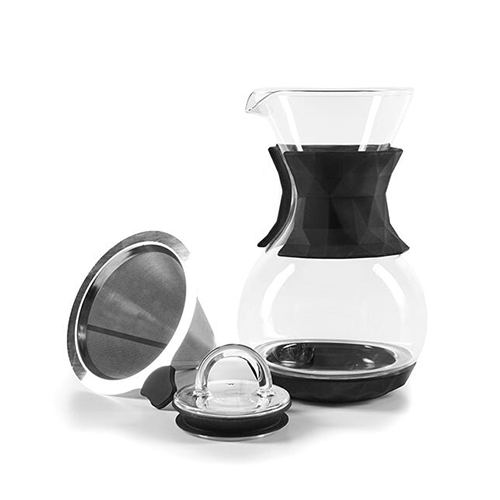
The overall look of the Uno Casa Pour-Over manual drip coffee maker is similar to the Chemex. It is a single piece of glass in a rounded hourglass shape. It comes with a heat-resistant silicone collar to make pouring easy.
A key difference is that the Uno Caso does not require paper filters. It includes a stainless-steel mesh filter that fits into the brewer. This reusable filter has a tab handle, so it's easy to insert and remove.
When used without a paper filter, it produces a full-bodied cup with characteristics similar to a French press but without grounds. The filter can be difficult to clean because of the double-layer mesh. You can use a standard #2 cone filter for a cleaner coffee.

Many consider the Kalita Wave to be almost foolproof. Kalita Wave is very forgiving about your pour technique. The inside of the dripper has 20 horizontal ridges. This design has one primary purpose: to minimize the contact between the filter and the side of the pour over coffee dripper.
The Kalita Wave is easy to use. You can simply fill it up, allow it to drain, then fill it up again. The three holes on the bottom prevent the water from draining out too quickly. Of course, you can use a slow pour to bring out the nuances of the bean.
While the Kalita Wave pour over coffee dripper comes in ceramic, glass, and stainless steel, we recommend the ceramic version. The stainless-steel version is prone to clogging and the glass version can be quite fragile. Another benefit of the Kalita Wave ceramic coffee dripper is that, when pre-warmed, it can keep the water at a consistent temperature.

Bee House is a Japanese brand known as Zero Japan in the U.S. The Bee House Ceramic Coffee Dripper is an excellent pour-over coffee maker that features an ergonomic handle.
The interior is designed with vertical ribbing and two drain holes to regulate the outflow, ensuring even extraction and a satisfying cup of coffee, regardless of your pouring technique. Even without a gooseneck kettle, the Bee House dripper can help you consistently brew a great cup of coffee, unlike some other manual brewers.
A particularly nice feature of this dripper is its see-through base design, allowing you to see how much coffee is in the cup without lifting the dripper. This helps prevent overflowing the cup. Read More Information Here

When looking for the best pour over coffee maker, you have to consider the one that started it all. Melitta has been in the pour-over coffee business for over 100 years. You can find Melitta coffee filters in almost any grocery store.
The product we're focusing on here is the black, 1-cup plastic dripper. You can also get the 1-cup dripper in clear or translucent red plastic. If you prefer a more sustainable material, they make ceramic 1-cup drippers in a variety of colors. Need coffee for a crowd? You can opt for the 20-ounce ceramic dripper and carafe set, 52-ounce dripper plastic dripper with a glass carafe, or the 60-ounce plastic dripper with a thermal carafe.
Like the Bee House ceramic drippers, all of the 1-cup plastic drippers have a base design that lets you see how much coffee is in your cup. This is helpful to prevent overflow.
A big plus for the Melitta dripper is its price. These cost less than $10, and you use your own mugs. That makes it great for folks who are just beginning to explore the world of manual drip coffee.
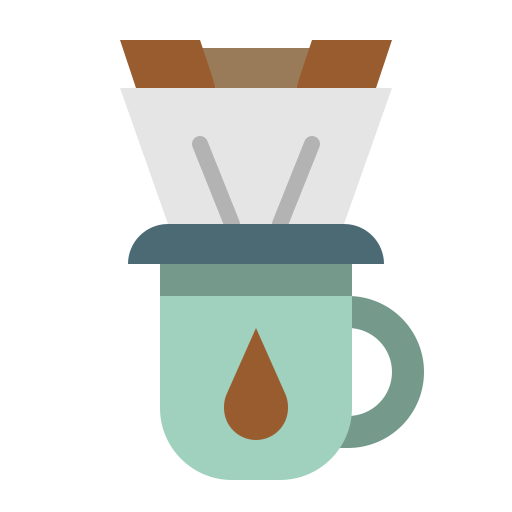
In the early 1900s, the first pour-over dripper was made from a metal can. Ceramic and glass drippers came next. The first commercial plastic dripper was introduced in 1960. Here, we’ll explore the advantages and disadvantages of each type of material.
There are reasons why coffee carafes are usually made of glass. These reasons also apply to the glass pour over coffee maker. First, it won’t alter the flavor of the coffee. You can’t taste glass as you can with plastic or metal. The other benefit is that it won’t stain. The key disadvantage is that glass is fragile. One wrong move and it’s time to purchase a new one.
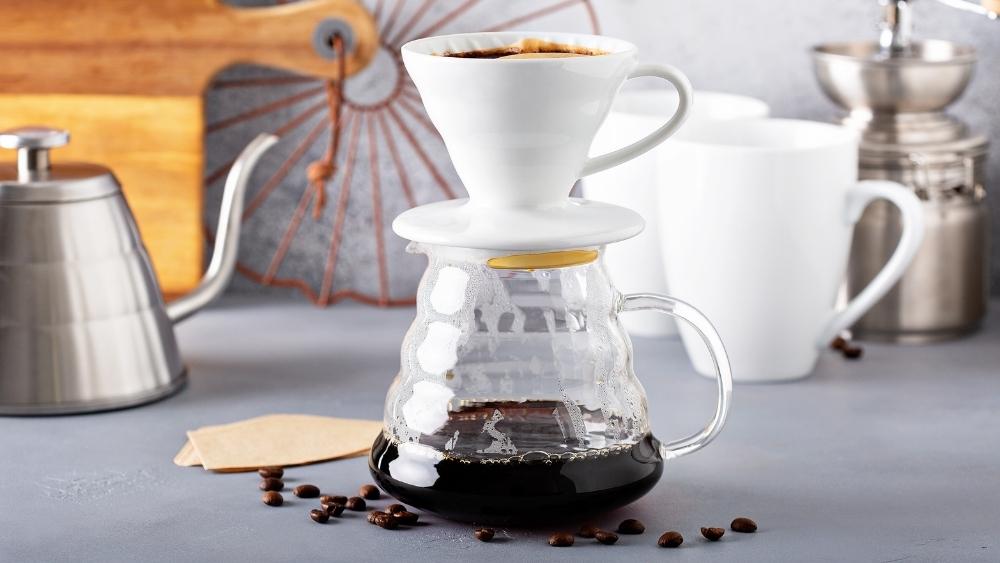
Like glass, a ceramic dripper will not impart any unwanted taste to the coffee. A major benefit of ceramic is its ability to retain heat. When you preheat the dripper with hot water, a ceramic dripper can help keep the water at the perfect brewing temperature.
While it’s sturdier than glass, it is also prone to cracking and breaking. Also, ceramic drippers are sometimes quite heavy.
Metal drippers rate high as far as weight and durability. But metal, especially stainless steel, doesn’t retain heat very well. When the temperature drops, then the level of extraction is compromised.
While metal drippers can last a very long time, if not insulated, they will produce less than perfect results. If you want a metal dripper, look for one that is insulated like the Fellow Stagg.
The biggest advantage of plastic can also be seen as its biggest disadvantage. A plastic dripper will last a very, very, very long time. While great on your pocketbook, it’s not so great for the environment.
But another plus for plastic is its weight. Lightweight and durable, a plastic dripper is ready to accompany you on any adventure, anywhere. While plastic drippers used to be looked down on, more and more coffee experts are recommending them.
These days, most plastic will not impart any unwanted taste and will not leach any harmful chemicals into your brew.

A major difference between drip coffee brewers, both automatic drip and the manual pour-over dripper, is whether it has a flat or conical bottom. Are you wondering which one is the best pour over coffee maker? The answer is: it depends.
Many consider the flat-bottom dripper to be easier for beginners. The reasoning is that the flow rate is controlled in part by how many and how large the holes in the bottom are. However, darker roasts and lower-quality coffees tend to perform better in a cone filter. Because these are the types of coffee many beginners choose, some recommend the conical bottom dripper.
Until recently, it was mostly speculation and anecdotal references about the difference between cone- and flat-bottom filters. But in 2019, the Specialty Coffee Association posted an article called Flat vs. Cone: Basket Shape is as Important as Grind Size in Drip Brew Coffee.
The study indicates that yes, all other factors being equal, tasters can tell the difference between a flat and cone-shaped dripper. In light roasts, the flat-bottomed drippers enhanced the dried fruit, sweet, and floral flavor notes in the coffee. The cone-shaped drippers enhanced the citrus, berry, and sour flavor notes.
A similar difference was found with darker roasts. The flat-bottom brewers brought out the chocolate, cocoa, and woody notes. The conical brewers seemed to enhance the bitterness. In the end, it really comes down to personal choice. But we will say this: with conical drippers, it’s essential to use the slow pour method to regulate the rate of water flow. If want to just fill the dripper with water and walk away, you’ll probably want a flat-bottomed version.
Our reviews of what we consider to be the best pour over coffee maker give you a lot of information. Here are a few things to think about to help you narrow your search.
Do you want to brew a single cup of coffee or enough for a gathering? The vast majority of drippers will make enough coffee for one or two people. That’s a primary reason why many people choose pour over coffee makers.
But what if you need more than that at a time? You can find pour over drippers that can brew 8, 10, or more cups of coffee at a time. These usually come as a pour over coffee kit.
Where do you want to brew your coffee? If you plan to only brew coffee at home, then you might want a ceramic or glass pour over coffee maker. However, these don’t work well if you plan to travel (or are clumsy when you’re sleepy).
Plastic brewers are lightweight and durable. If backpack space is an issue too, you might consider something like the MiiR Pourigami that can fold up and fit in your pocket.
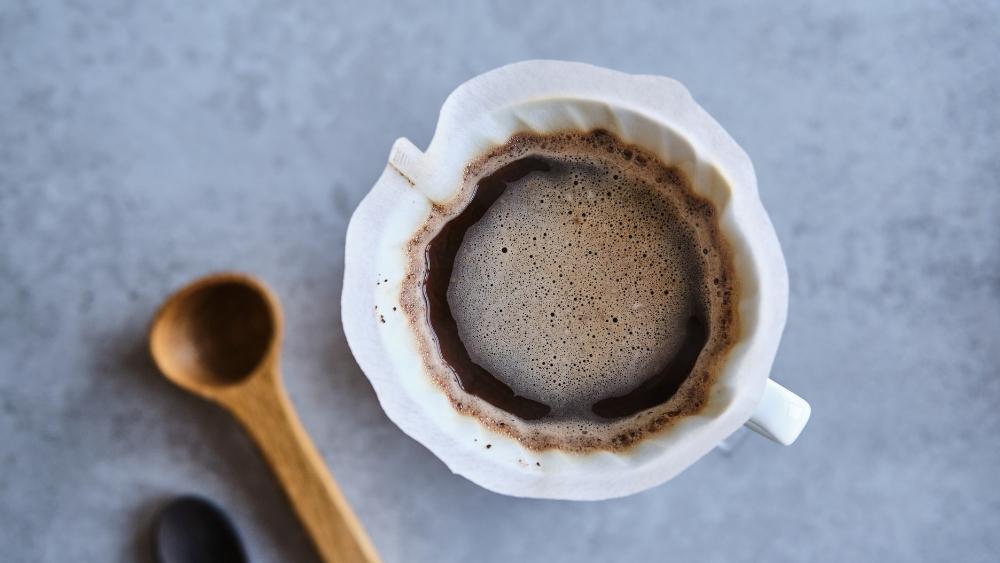
Many love the ritual of slow pouring hot water from a gooseneck kettle over freshly ground beans. But not everyone loves to babysit their coffee. If the idea of spending three to five minutes slowly pouring water makes you twitch, then opt for a brewer that you fill up and let brew.
If that’s you, you might enjoy brewers like the Clever Coffee Dripper. It has a stop valve so you fill it up, let the coffee steep, then release the brew into your cup of coffee.
Some brewers, such as the Chemex, are fairly technical. They require care and skill to brew the perfect cup of coffee. But your efforts will pay off when you master the technique. If you just want a simple device that makes great cup of coffee, you’ll find many drippers on our list that are easy to use.
You know how much of the cost of a printer is buying ink? You want it available the moment you need it, and you don’t want to go broke using it. The same applies to dripper filters. Some specially designed drippers require you to use their specially made, branded paper filters.
Often these aren’t readily available at your local grocery store. If you don’t want to have to plan ahead on filter purchases, look for a pour over coffee dripper that uses standard filters. Of course, there are drippers that have a reusable mesh filter. With these, you’ll never need to buy paper filters again.
Pour over coffee is a manual method of brewing. It allows you to precisely control water temperature, flow rate, saturation, and volume. It’s an excellent method for bringing out nuanced and delicate flavors, especially in single-origin coffee and lighter blends.
Delicious cup of coffee! This method can bring more flavor and aroma out of your ground beans. It can also give the coffee a cleaner taste and enhance the sweetness and fruitiness.
Not if you make it correctly. You have complete control over how weak or strong your cup of coffee will be. Of course, if you want weaker coffee, you can do that. We just don’t understand why.
Pour over coffee maker is a manual form of drip coffee. When people refer to drip coffee, they are often talking about automatic drip brewers.
To get the best pour over coffee, you need to start with freshly ground, high-quality beans. The grind size depends on the type of pour over coffee dripper you have. Brewers like the Chemex use a medium-coarse grind. Flat-bottom drippers usually require a medium grind. Other cone-shaped brewers want a medium-fine grind. Refer to your brewer’s manual to see what is recommended.
Single-origin and lighter roasts are often chosen for the pour-over brew method. When brewing coffee, this method brings out the delicate flavors you might lose in other brewing methods. Of course, you can brew any coffee in a pour-over dripper.
Yes. Many pour-over drippers and very inexpensive. In terms of time and effort, that depends on how particular you are. Some coffee drinkers will slam any old swill and not care.
Others strive to get the best flavor and experience from their specialty coffee beans. If you’re in the second category, then yes, the extra trouble is worth it.
With all brew methods, the ratio of water to ground coffee is critical. According to the Specialty Coffee Association, the ideal ratio is 55 g/L ± 10%. In plain English, that’s about 1 part ground coffee to 17 or 18 parts water.
When you first pour hot water over ground coffee beans, a substantial amount of carbon dioxide is released. This de-gassing process can disrupt the contact between the grounds and the water, giving you under-extracted coffee.
By saturating the grounds with a small amount of water and waiting, you give time for the gas to escape. This gas bubbling up like foam is what is referred to as the bloom. Then you can pour the rest of the water and get optimal extraction.
Yes. When paper coffee filters are made, a lot of paper dust is created. Pouring hot water into the filter while it is in the dripper does two things. First, it washes away the dust so your coffee won’t have a paper taste. Second, it preheats the dripper.
Our pick for the best pour over coffee maker is the Clever Coffee Dripper. This dripper has a valve at the bottom that you can close. It can give you the full extraction of immersion brewing yet the clean taste of pour-over.
This brewer is especially good if you don’t want to get a gooseneck kettle or worry about the precise pouring method. Another good beginner dripper is the Kalita Wave.
If you’re more experienced and want to finesse your coffee, then you might prefer the Chemex or Hario V60. What if you’re on the go?
If you want your dripper to travel with you, then check out either the MiiR Pourigami or one of the lightweight, plastic drippers. Whichever dripper you choose, we trust you’ll enjoy the world of brewing pour-over coffee at home.
